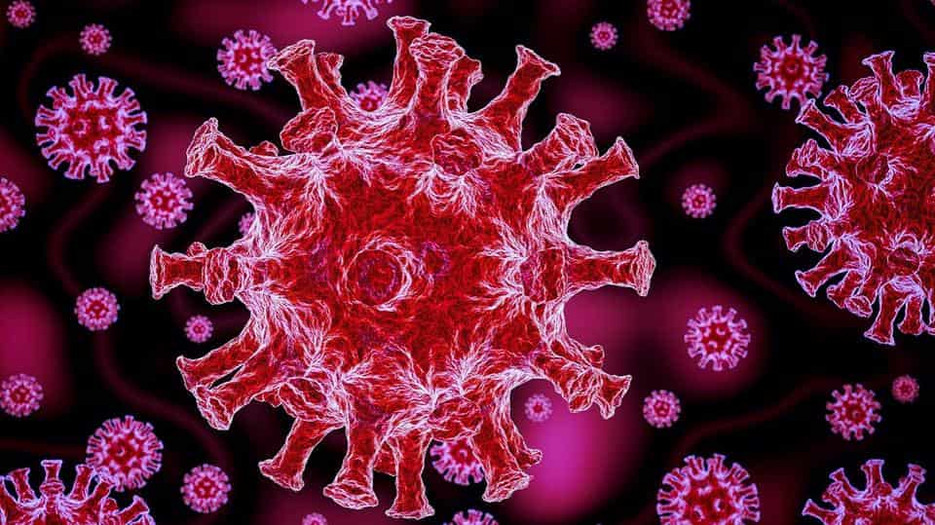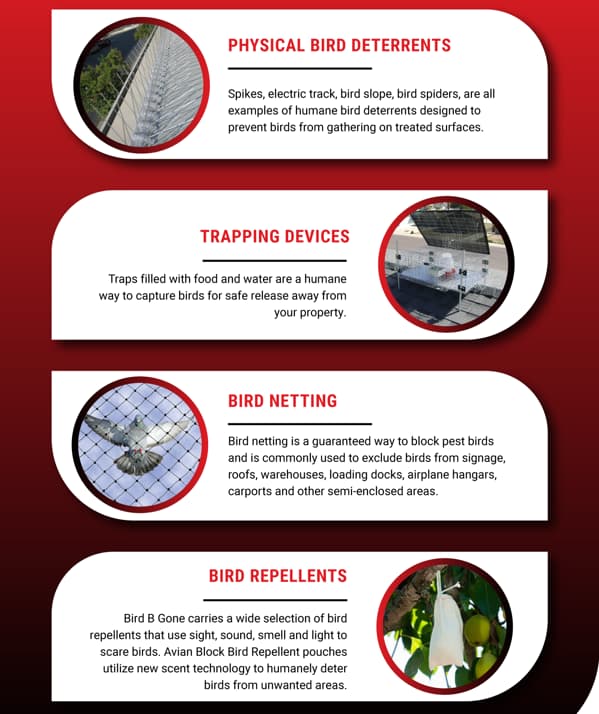Please add the schema tags below
Do Birds Carry Disease? Bird Poop the Avian Super Spreader
Disease and how it’s spread are truly the topics of the day. While COVID-19 and the pandemic have everyone on the street talking about these issues, bird control experts have been discussing the spread of disease for years.
Do Birds Carry Disease?
Yes, birds carry disease. They carry lots of diseases—more than 60 and 40 different parasites, in fact. Our feathered friends carry serious, life-threatening, communicable diseases such as histoplasmosis, candidiasis, cryptococcosis, salmonellosis, E. coli, and many others you’ve likely never even heard of.
Avoiding the spread of disease is one of the most important reasons to implement strong and effective bird control programs.
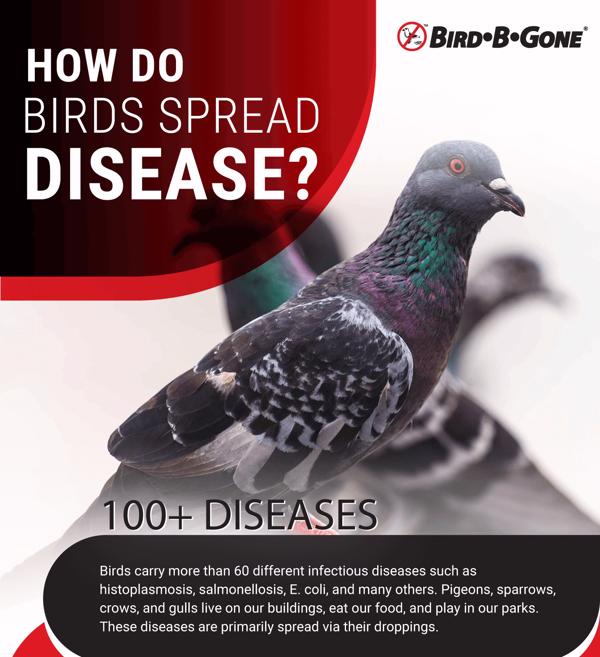
How Do Birds Spread Disease?
Diseases fall into five major categories: bacterial, viral, mycotic (fungal), rickettsial, and protozoal. Diseases in each of these categories need to move from place to place and host to host in order to spread.
Birds are super spreaders; they travel over wide distances, and their bodies are hosts to infectious diseases. Luckily, humans and birds really don’t interact very much, but some bird species have adapted to urban life. Birds such as pigeons, sparrows, crows, and gulls nest on our buildings, eat our food, and play in our parks. These birds are a nuisance and pose a significant health risks to those around them.
Before you get too far wondering how we’re ever going to convince birds to wear face masks and wash their “hands,” it’s important to know that birds aren’t spreading disease via their contaminated breath; they’re primarily spreading it via their droppings.
Bird poop is full of disease, which makes it the most common way birds transmit diseases to humans. One hundred pigeons can produce up to 4,800 pounds of poop in one year. That’s 4,800 pounds of disease-ridden poop. If you’re like most folks, you avoid coming into direct contact with bird droppings; if we’re all avoiding bird feces, how then is disease able to spread?
Diseases pass from bird feces to humans in three ways.
Food and Water Contaminated by Pigeon Poop
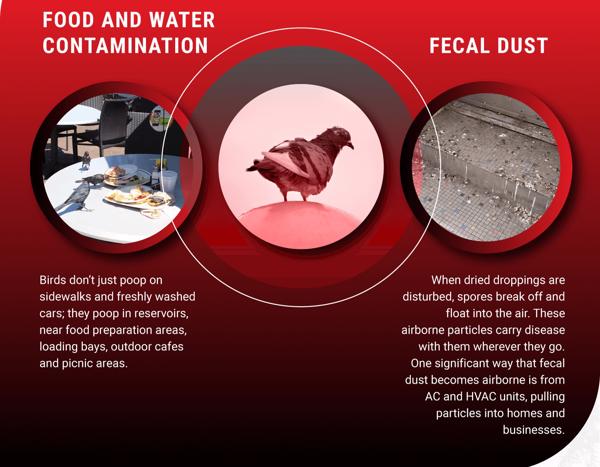
Birds don’t just poop on sidewalks and freshly washed cars; they also poop in lakes, rivers, and reservoirs. They poop near food preparation areas and near loading bays. They poop in outdoor cafes and picnic areas. Since birds are attracted to food and water, it’s not a big leap to imagine that they are leaving most of their droppings near food and water.
The health risks to humans from this are real. For example, in 1993, a series of mysterious ailments in Yonkers was traced to drinking water contaminated by seagull droppings. Health inspectors will quickly shut down any food-related facilities if evidence of bird droppings is present.
Fecal Dust from Bird Poop
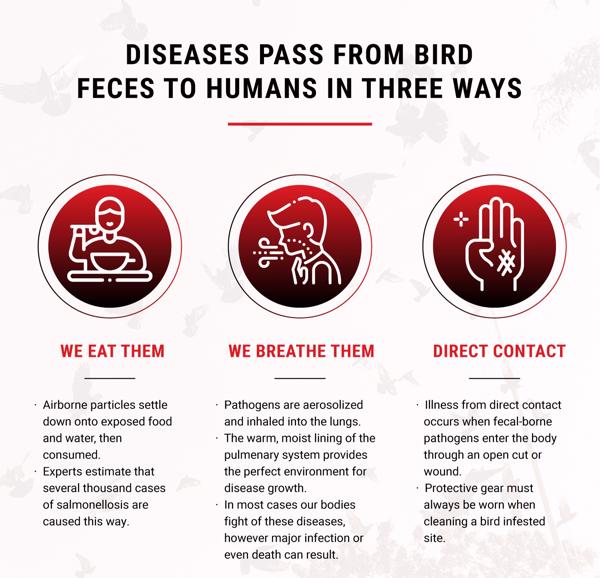
Yes, this is a real thing. When dried droppings are disturbed, microscopic pieces break off and float into the air. These airborne particles carry disease with them wherever they go, and they can go anywhere.
One significant way that fecal dust becomes airborne is through HVAC units. Drying bird feces in air ducts and vents quickly becomes aerosolized, and the particles blow out into homes and businesses. These tiny, freewheeling pockets of pestilence cause all sorts of trouble, getting into the human body in three main ways:
1) We Breathe Them In
This is a big one. Fecal dust enters the body and settles into the warm, moist lining of the lungs where diseases love to grow. We’re all breathing in this stuff every day, and most of the time, our bodies can fight off the disease without us ever noticing. But sometimes, major infections and even death are the result.
2) We Consume Them
Airborne particles settle down onto exposed food and water and are then consumed. Experts estimate that several thousands of cases of salmonellosis are caused this way.
3) Direct Contact
Illness from direct contact occurs when the spores and particulate from bird droppings enters an open cut or wound. Infected wound sites become red and puffy, and antibiotics are needed. This is why protective gear must always be worn when cleaning a bird infested site.
What Should You Look Out For?
Understanding the health risks posed by nuisance birds is the first step. Beyond that, it’s important to remember that bird infestations should be evaluated rationally from a public health perspective.
One pigeon sitting on a lamppost isn’t a cause for alarm; an entire flock of pigeons perpetually perching on your rooftop air ducts is a problem. Nests and droppings around vents, evidence of birds near food production sites, and large quantities of droppings in enclosed spaces all pose a health risk and necessitate action.
Finally, driving away the birds isn’t enough. You have to clean and disinfect the area to eliminate the health risk.
Proper precautions must always be taken. Personal protective equipment (PPE)—goggles, respirators, and protective clothing—must be worn to safely clean up bird droppings, especially in enclosed areas.
What’s the Solution?
Bird B Gone is the world’s leading provider of bird control solutions. We have the experience, tools, and information you need to keep your property safe from the health risks posed by nuisance birds. We’ll help you develop a plan to drive birds away and keep your space safe and healthy.
We have a number of effective and humane bird control solutions to choose from, including:
1) Physical Bird Deterrents
Spikes, electric track, bird slope, bird spiders, and all examples of humane bird deterrents designed to prevent birds from gathering on treated surfaces. These products are extremely effective at deterring birds, but it’s not always feasible to implement these types of solutions on every possible surface.
2) Bird Netting
Bird netting is a guaranteed way to block pest birds and is commonly used to exclude birds from signage, roofs, warehouses, loading docks, airplane hangars and other semi-enclosed areas.
3) Bird Repellents
Bird B Gone carries a wide selection of bird repellents that use a combination of sight, sound, smell and light to scare birds away. Bird gels, including our SpectrumV Holographic Bird Gel, are often an excellent choice and are used to prevent birds from congregating in specific areas.
4) Trapping & Relocation
Trapping and physically removing birds is a good solution for high-traffic, enclosed areas where several birds are causing trouble. Traps filled with food and water are a humane way to capture birds for safe release away from your property.
Your bird control plan will typically need to involve a strategic combination of these bird control products to be effective. Working closely with the bird control experts at Bird B Gone will help you develop and maintain a bird control program that will keep your property safe from bird-associated health risks. We’re here to help with product selection, installation, and cleanup.
Don’t Wait, Take Action!
Start by downloading our 8 Tips on How to Clean Up Bird Droppings guide. Protect yourself from birds and diseases with safe and effective bird control solutions from Bird B Gone. Get the help you need to evaluate your risks and create a plan. Don’t wait; start today!

